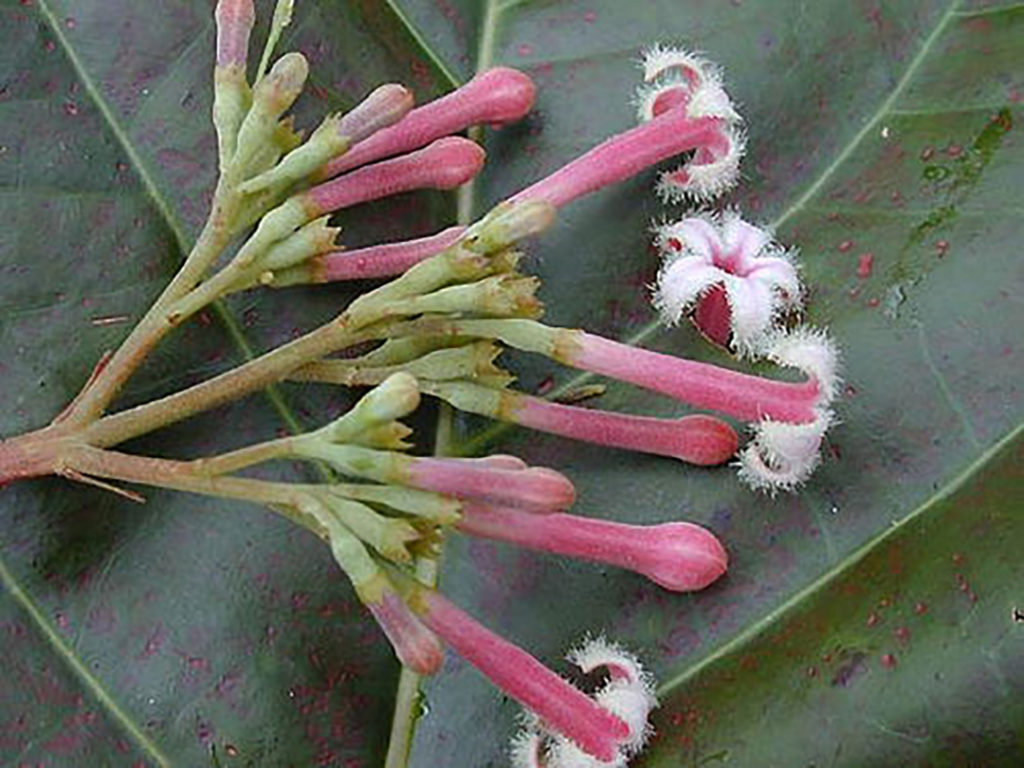
Ecuador
Quina
Sinchona succirubra

General Description / Cultural Significance
The national tree of Ecuador is quina, Sinchona succirubra, a tree with small fragrant reddish-colored flowers. Ecuadorians know the tree and its scent well, and use it for many medicinal purposes. It became renowned for its natural effectiveness against malaria, a discovery that is often attributed to Jesuit missionaries. Ethno-botanical literature documents that the bark of the tree has long been used for its antibacterial and antiviral properties to treat fevers, fatigue, gastrointestinal issues and more, but most importantly, malaria. Although, there are many accounts of the quinine laden bark being used as a natural remedy for cancer, especially of the breast, glands, liver, and spleen. Concoctions of the bark have also been traditionally used to treat everything from colds and hangovers to flus, pneumonia, and typhoid. The bark is stripped from the tree, dried, and crushed into a rough powder to be made into a variety of tinctures and other therapies.
In some areas of Ecuador, quina is cultivated, and this is not a small matter. The tree is very sensitive to temperature. It prefers a cool climate with minimal change in temperature between day and night, and between seasons. It was eventually learned that the bark could be delicately removed in a way so that it would grow back. Moss is grown on the trees, which seems to increase the concentrations of alkaloids in its bark, such as cinchonine, cinchonidine, quinine, quinidine, and quinamine. The bark not only holds the medicinally active compounds that are anti-malarial, but quinine contains a stereoisomer quinidine used in medicines to treat heart and blood disorders, such as arrhythmia, anemia, and varicose veins.
Climate Change/Conservation Status
In earlier centuries, the Quina was heavily exploited, both by locals and visitors from other countries. However, after quinine was synthesized, exploitation decreased to some extent. Even in the 21st century, with synthetic antimalarial treatments available, the high cost limits its use. The World Health Organization (WHO) reports that because a child dies of malaria every thirty seconds, countries should rely on natural products from the tree to treat those affected.
The problem now is that the widely cultivated Cinchona succirubra has become an invasive species in some locations due both to its reduced exploitation and to the fact that its seeds are spread by the wind and its production of suckers. Its invasive tendencies have had a significant impact on other endemic species of flora, particularly in the Galapagos.
Cotopaxi, an active volcano and the main source of water for Ecuador’s capital, Quinto, has experienced a massive reduction in glacier coverage. Michigan University reports that in the last 30 years, the Andean glaciers have lost 30 to 50% of their mass. Alarmingly, researchers expect the glaciers in the Andes to retreat 55% more between 2050 and 2100, and temperatures are predicted to increase in the Amazon between two and eight degrees Celsius. Despite the country’s heavy investment in renewable energy, geothermal, solar, wind, and biomass, the country expects to be greatly affected by climate change. Because of its extensive geographical range, the quina tree is not threatened at this time. However, the United Nations Development Programme (UNDP) predicts that Ecuador is increasingly vulnerable to the impacts of temperature changes and weather variability. As quina trees are sensitive to temperature variation, this forecast suggests the potential for future risk to the species.
Alternate Names
Chinchona bark
Fever tree
Jesuit’s bark
Peruvian bark
Quina-quina
Red chinchona
Sources
CABI, 2019. Cinchona pubescens (quinine tree). CAB International. [website]
Climate Change Knowledge Portal, 2019. Ecuador. World Group Bank. [website]
Climate Links, n.d. Ecuador. US Agency for International Development. [website]
Embassy of Ecuador, Washington, D.C. This statement can be found on the World Sensorium original website.
The Global Invasive Species Database, 2010. Species profile: Cinchona pubescens. Invasive Species Specialist Group. [website]
Hasan, M., & Wyseure, G., 2018. Impact of climate change on hydropower generation in Rio Jubones Basin, Ecuador. Water Science and Engineering, [website] 11(2), pp.157-166.
Jimenez, N., 2019. Climate change threatens 2 of Ecuador’s 7 glaciers. EFE. [website]
Moore, M., 2019. Cinchona. U. S. Cinchona, Cinch. [Peruvian Bark, Yellow Peruvian Bark]. Cinchona Rubra, Red Cinchona. Henriette Kress. [website]
Noboa, E. (2013) ‘Interview with Eduardo Noboa, Undersecretary of Climate Change Ecuador at EUROCLIMA’. Interview by Juan Fernando Villa Romero, Ecuador steps up its fight against climate change. 6 Nov. [website]
Sturluson, T., n.d. Cinchona Bark Uses and Benefits. The Herbal Resource. [website]
UNDP, n.d. Manejo de recursos hídricos, clave para combatir el cambio climático en Ecuador. United Nations Development Programme. [website]

